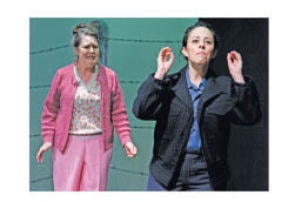Lauding Langham’s Laramie
When a theatre company takes on a challenging, lauded play like The Laramie Project — particularly a volunteer-based community outfit like Langham Court — it can be a risky endeavour. And not just because of the show’s content, which deals with the brutal beating and murder of a gay college student in Laramie, Wyoming; there is also a concern that a smaller company with budgetary limitations may not have the resources to do the script justice. I’m happy to report that Langham’s Laramie doesn’t merely do the play justice — this is a production that is a high watermark not just for their current season, but for the five years I’ve been attending shows there.
When the world’s gaze was drawn to Laramie in 1998 after 21-year-old Matthew Shepard was savagely beaten, tied to a barbwire fence and left to die in an apparent anti-gay hate crime, New York City’s Tectonic Theater travelled to the small town to create a play. Moisès Kaufman and the other Tectonic members conducted hundreds of interviews with residents of Laramie and crafted The Laramie Project from transcriptions of said conversations. The result is docu-theatre; the story of Shepard — and, eventually, the community of Laramie — is told via short vignettes involving various community members and even the Tectonic Theater members themselves.
Director Roger Carr has assembled a massive 33-person cast to portray the 60-plus characters in the play, and there wasn’t a weak performance in the bunch. From eccentric limo driver Doc O’Connor (played by Kevin Stinson) to Nicole Evans’ take on sassy policewoman Reggie Fluty, all of the cast members gave convincing, heartfelt performances. Highlights were definitely Dusty Smith’s tear-jerking speech as Matthew’s father Dennis Shepard, Sean Baker as University of Wyoming student Jedadiah Schultz, Evans’ turn as Reggie Fluty, and Girodana Venturi as Matthew’s friend Romaine Patterson.
The show is extremely well-directed; the short scenes and large number of characters mean there is a lot of coming and going, but Carr has ensured it’s all very fluid — a scene involving four local ministers was particularly well done. While I enjoyed the majority of Karrie Wolfe’s lighting design, there were a few instances where strong shadows on faces were a bit distracting.
Julius Maslovat has crafted a simple and functional set, comprised of four different levels and a few blocks, with the barbwire fence looming ominously in the background. Nancy Roach’s projections were very effective in some instances — images of the Wyoming skyline and flickering candles come to mind — but distracting in others, such as when we see pictures of the perpetrators’ vehicle pulling away or photoshopped road signs. But these are very minor complaints in what is a truly powerful theatre-going experience.
Sometimes, we go to the theatre to escape reality. Taking in a performance of The Laramie Project is not one of those times; each “you know?” and “like” in the script is a reminder that this play is comprised entirely of words spoken by real people affected by this tragedy. But sometimes, theatre is about witnessing a piece of work that will truly move you —and that’s what Langham’s production is sure to do.
